Introduction
- Fast fashion has become a common trend in many parts of the globe.
- Operations management is being embraced in this field to meet customers’ needs.
- The key operations of fast fashion businesses include sourcing, design, and distribution.
- Design is pursued using emerging technologies, fashion trends, and customer demands.
- Distribution and sourcing are done efficiently to support the needs of individuals in different regions.
Due to the changes experienced in the fast fashion industry, retailers have been forced to focus on quality, reduced price, and fast market entry. Sourcing is implemented using the famous lean or Just in Time (JIT) models. This means that required materials are acquired and delivered whenever they are needed. When operations managed is implemented efficiently, a given fast fashion company will achieve its goals much faster.
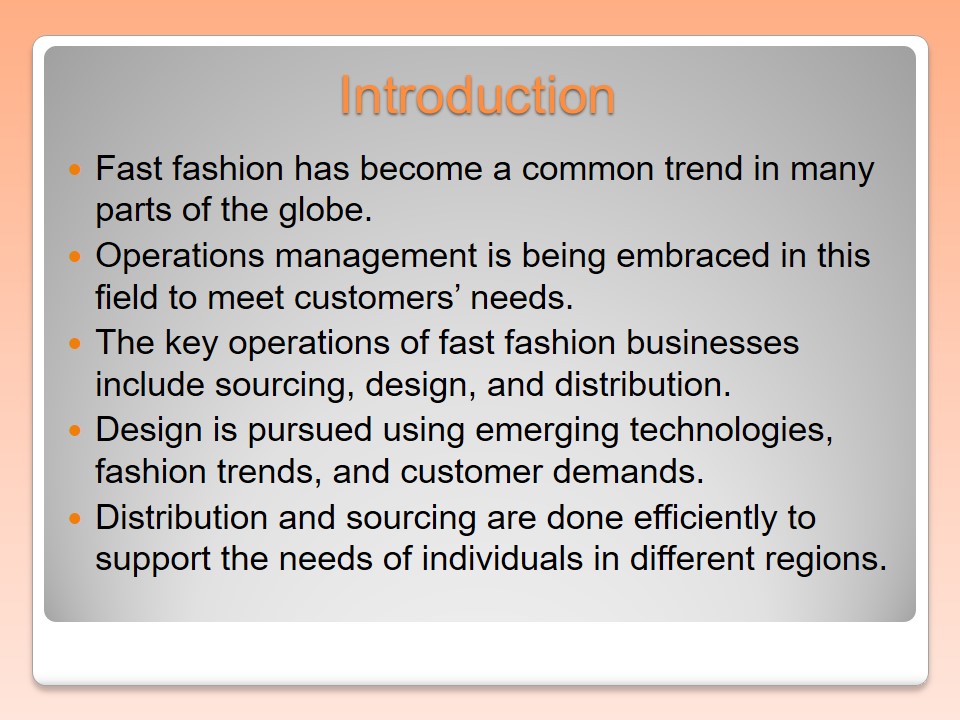
Key Operational Functions: Managers’ Roles and Responsibilities
Design
- This is the most critical function for fast fashion companies or retailers.
- The unique needs of different customers should be identified.
- Issues such as product design and processes are addressed during this phase.
- Facility design is taken seriously depending on the level of demand, potential changes, and number of employees.
During the “design” stage of operations, managers should liaise with key persons such as designers, advisors, and employees. They should allocate funds to catch up with trendy designs or fashions. They must also coordinate with key suppliers to ensure that everything is put in place. Managerial functions such as leading, empowering, and guiding are critical during this phase (Ciarniene & Vienazindiene 2014). Capacity planning should also be considered by managers. This practice results in demand estimation and can make it easier for a given corporation to respond to emerging needs.
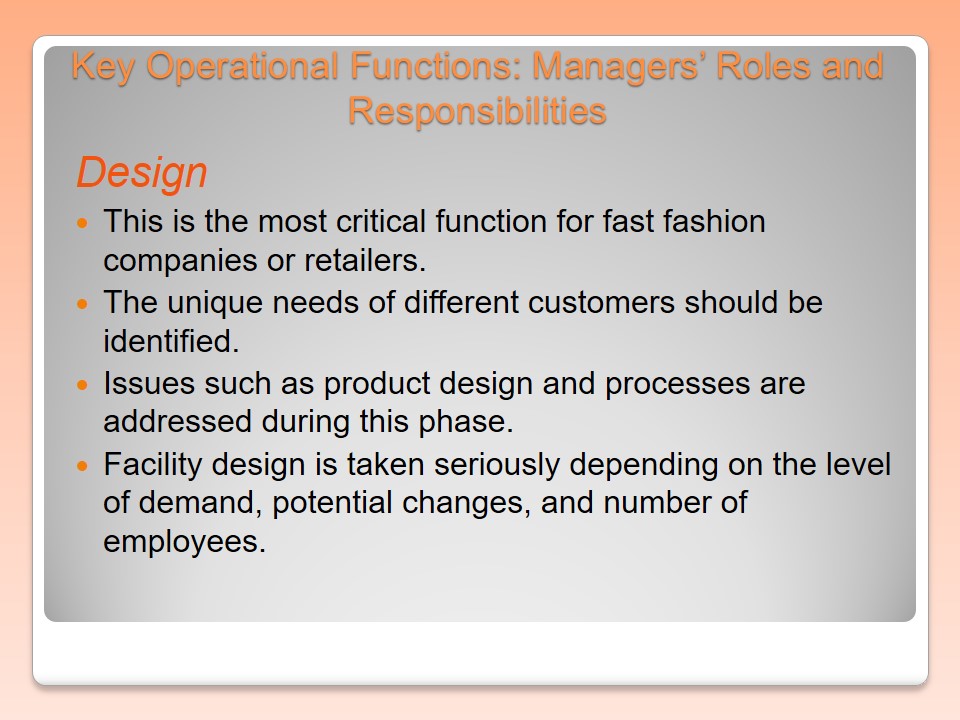
Implementation
- The manufacturing system is usually monitored continuously.
- Key decisions such as tradeoffs are made.
- Administrative roles are also pursued.
- Such practices ensure that employees are equipped with the right resources, empowered, and encouraged.
After the intended product has been designed successfully, the manufacturing system should be monitored to support the implementation process. Tradeoffs and other key decisions should be made. Individuals should be guided and trained to support the intended goals. Throughout this phase, managers have a role to engage in administrative functions. Hill and Hill (2018) indicate that leaders should also ensure that every employee operates in a safe working environment.
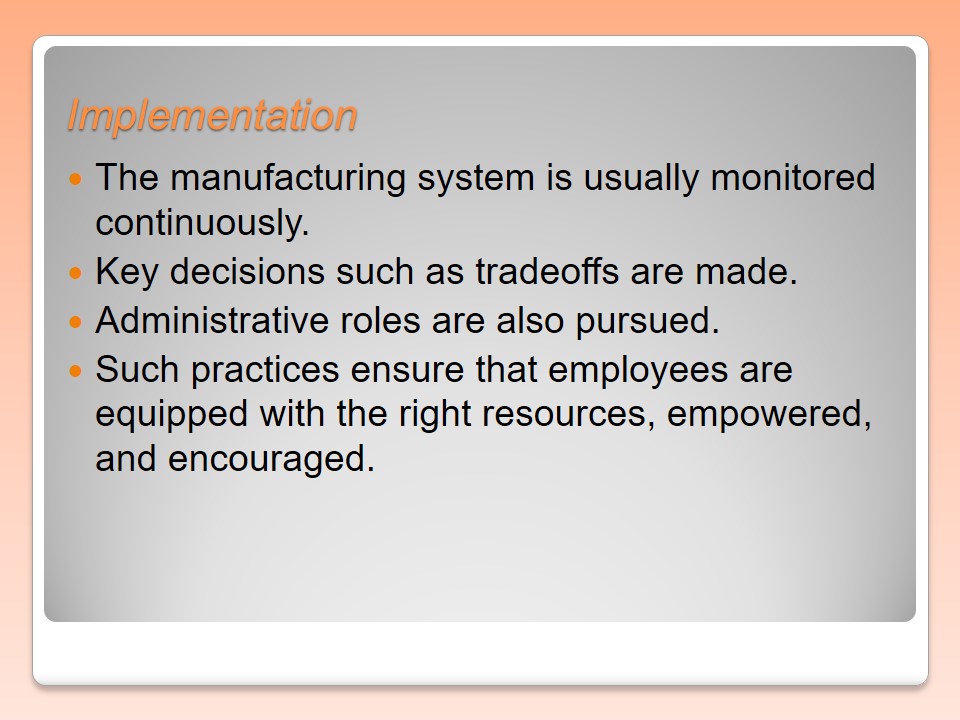
Planning, Sourcing, and Forecasting
- Planning decisions are made during this stage.
- Technological adoptions and introductions of superior systems are considered.
- Desirable raw materials are identified and sourced.
- Forecasting is also done whereby companies predict positive/desirable results or demanded quantities.
- The number of the targeted customers can also be estimated.
- Issues such as transportation and forecasting are considered during this phase.
Since emerging trends should be identified and replicated within the shortest time possible to meet the needs of different customers, long-range planning decisions are critical. Managers must also engage in production planning. This means that they should identify the right people and work size (Hill & Hill 2018). Training can be considered during this process to ensure that positive results are realized. Managers should liaise with suppliers and transporters to support the production process. Suppliers should be managed and guided to deliver superior raw materials efficiently. Scheduling will be done to ensure that completed products are available to the right customers in different markets. Leaders should engage in forecasting to predict the amount of clothes that must be ready for marketing at a particular time.
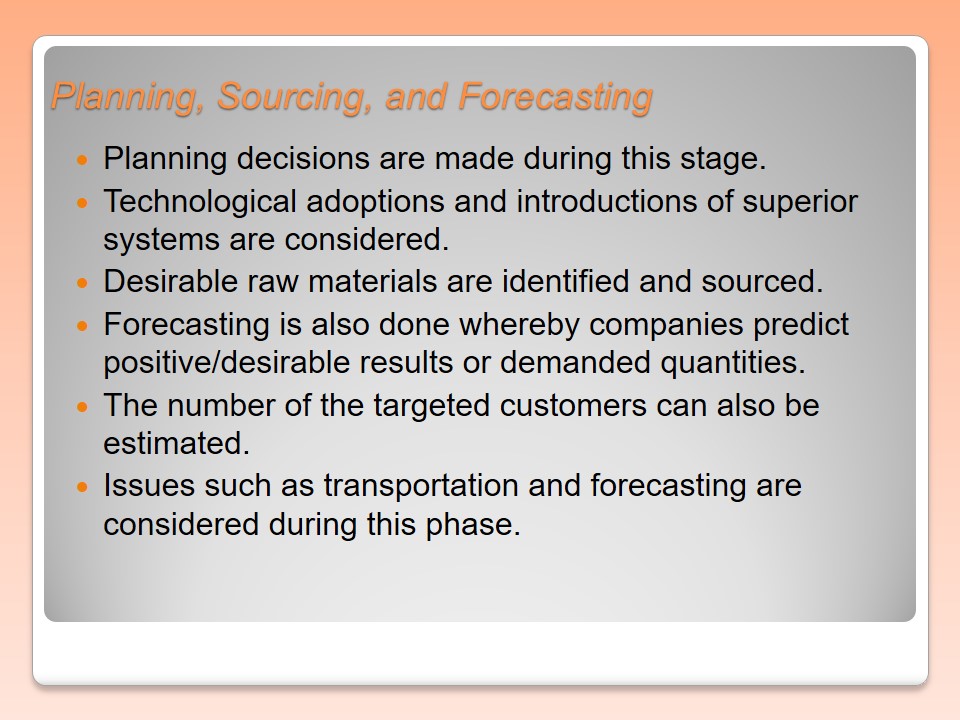
Distribution and Management
- The entire system should be managed throughout the production and distribution processes.
- Managers should coordinate with different stakeholders to improve performance (Lion et al. 2016).
- Issues such as teamwork, organizational culture, and lifelong learning should be supported by those in power.
- Material management improves the delivery process.
- Managers should address questions such as targeted orders, timing, and quality.
The purpose of this stage is to make sure that every final product is of the highest quality. It should also be transported and marketed efficiently. Managers must promote practices such as teamwork, decision-making, positive cultural practices, and lifelong learning (Libanio & Amaral 2017). Material management is also essential to promote quality and speed up the delivery process. Issues such as timing and quality should be taken seriously.
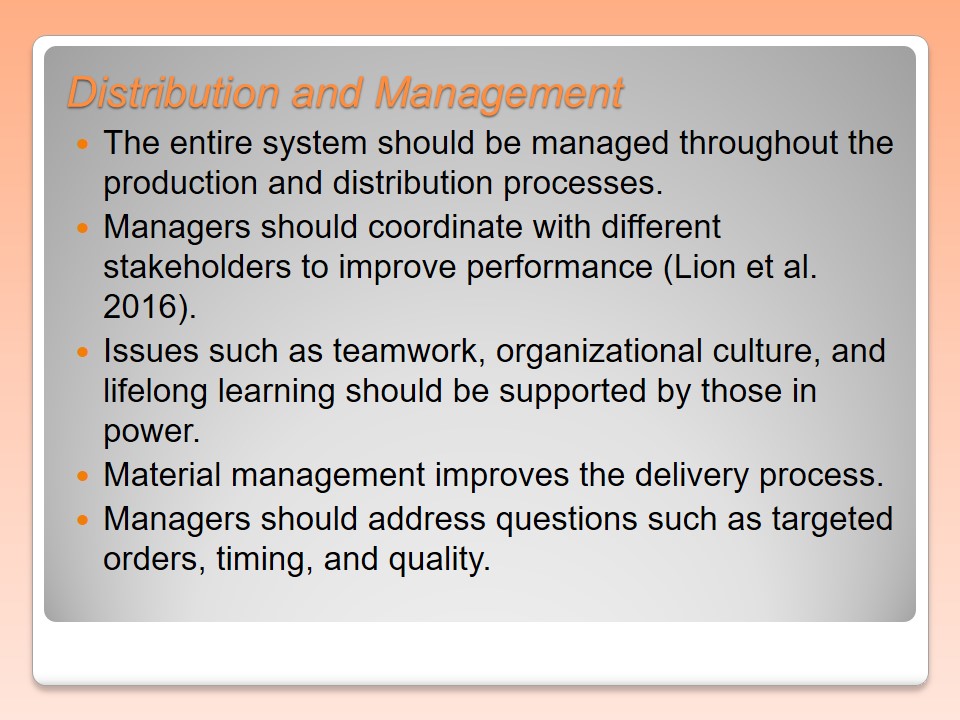
Approaches to Operations Management
- Just in Time (JIT) is the first approach to operations management.
- Inventory management ensures that the required materials are supplied in a timely manner.
- Product development is considered to deliver high-quality clothes to customers.
- HR function focuses on employee training, empowerment, and performance.
- Financial approaches are considered to deal with cash flow.
- JIT improves productivity and maximizes performance.
- Lean is another powerful approach.
- The method eliminates unnecessary wastes.
- Raw materials and supplies are acquired in a timely manner.
- Quality clothes are eventually produced.
- The needs of more customers are eventually addressed.
Operations management is a concept that is applied widely in different industries. In the fast fashion sector, concepts such as Just in Time (JIT) are embraced to manage various functions. With this kind of a model, inventory management ensures that the required materials are delivered in time. Finished clothes are packaged and delivered to the right customers immediately (Libanio & Amaral 2017). Product development focuses on the best approaches to introduce trendy fashions or clothes. Costs are considered in order to link the inventory and planning functions together. Under the JIT model, the marketing function is improved in such a way that new clothes are available to more customers. This approach supports consumers’ needs and maximizes profitability.
Another key approach to operations management is lean. This concept focuses on the ability to acquire resources whenever they are needed. Wastes are eliminated continuously throughout the manufacturing process. Every function is aimed at adding value to the final consumer (Choi & Li 2015). Materials are ordered and delivered on time, thereby minimizing chances of wastes. This approach to operations management is beneficial in the fast fashion industry since it ensures that quality clothes are manufactured without affecting quality.
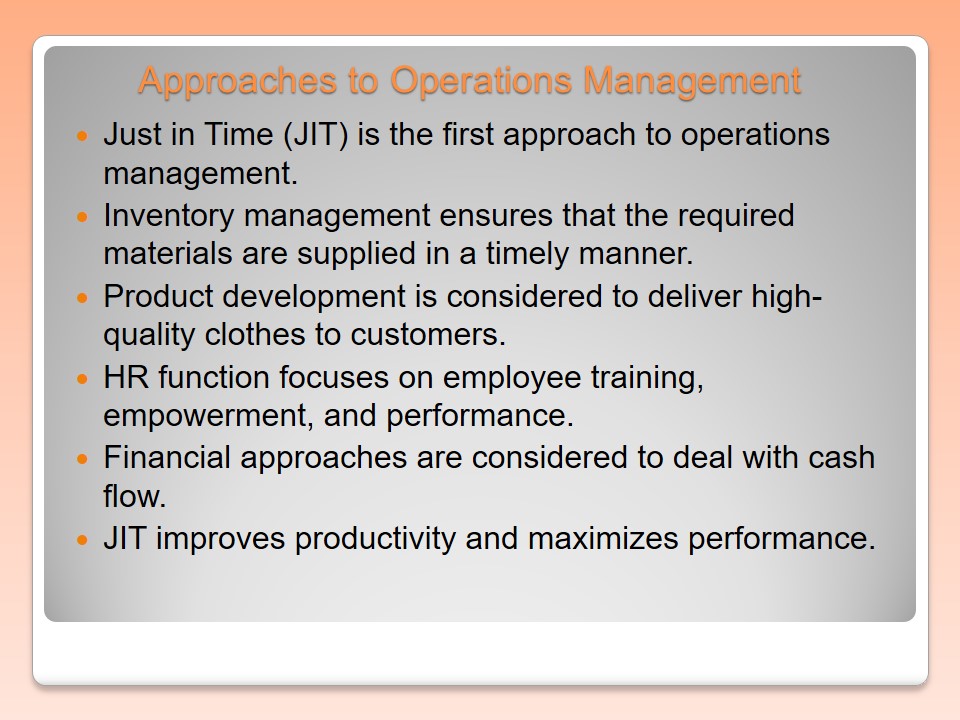
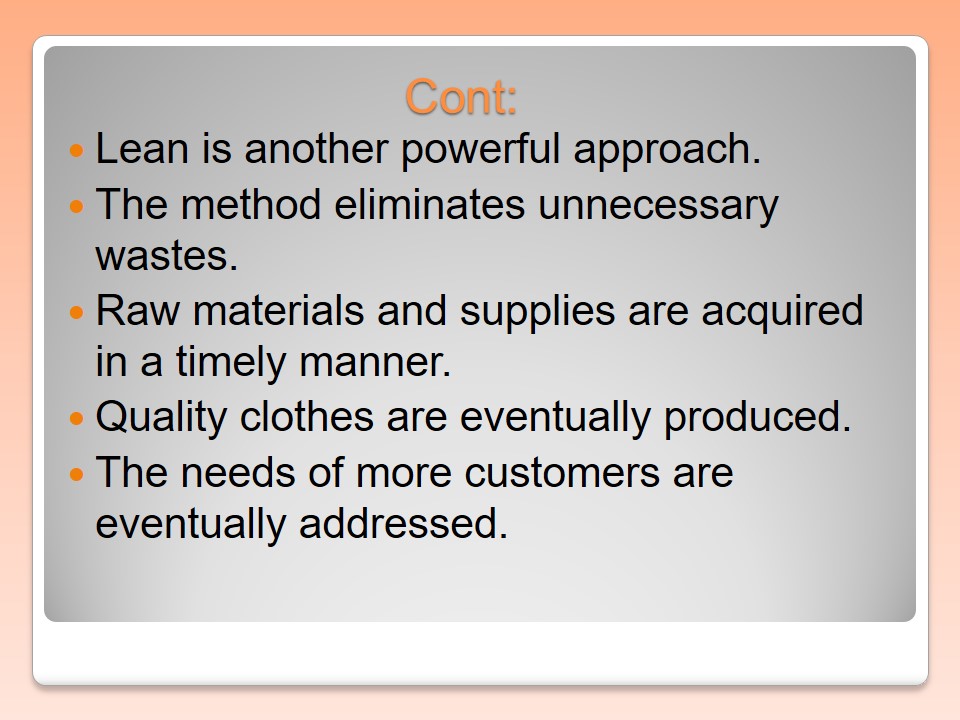
Factors Capable of Affecting Operations
Critical Factors
- Emerging technologies: New innovations and applications are being fuelled by the power of technology. Research and development (R&D) and the Internet are transforming advertising or marketing processes (Hu & Yu 2014).
- Social forces: These factors include changes in consumer expectations, increased income levels, and social media networks.
- Sustainability: This aspect focuses on the desire to protect the natural environment.
There are specific forces in the fast fashion business environment that continue to affect operations. Technology is transforming the way operations such as marketing, production, and outsourcing are pursued. The use of research and development (R&D) technology is supporting the goals of the fast fashion industry. The Internet is also transforming the way advertising/marketing should be done. Social forces are dictating the operations pursued by fast fashion businesses such as production, outsourcing, and product development (Choi & Li 2015). Due to sustainability concerns, this industry has flooded the market with short-lived clothes or brands. The problem has led to increased pollution and wastes. This factor is, therefore, encouraging managers to transform their operations in such a way that they can be friendly to the environment.
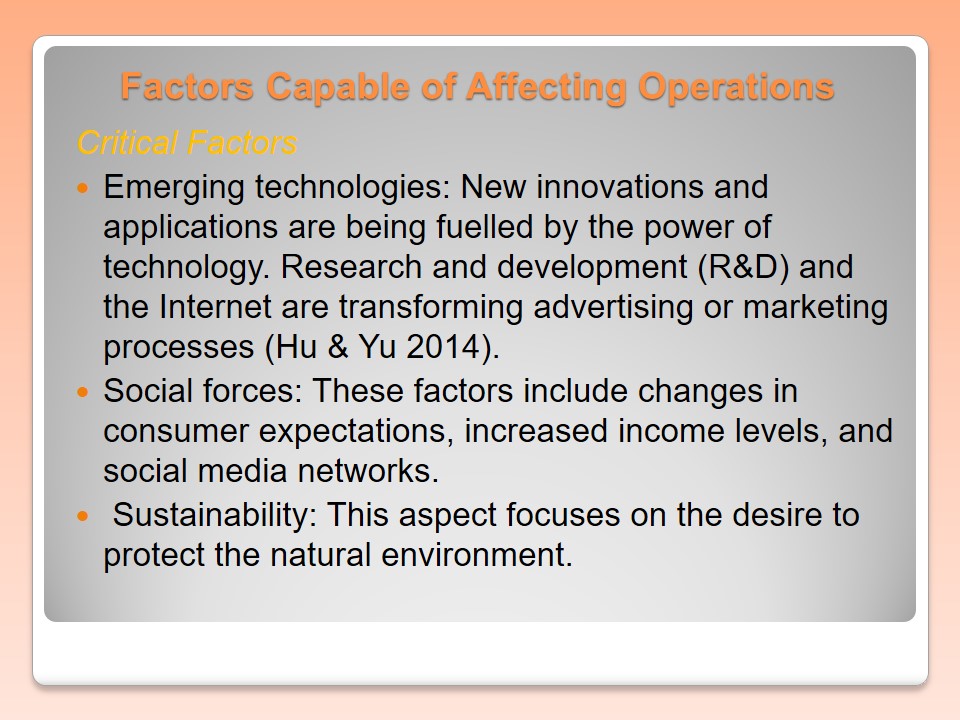
Managers’ Decisions
- Political and economic changes can force managers to pursue superior operations in an attempt to produce quality products.
- Social and technological changes are forcing managers to make adequate decisions whenever identifying the right production systems and facility designs.
- Existing or emerging laws are informing the decisions of these managers.
- E-retailing is dictating the way customers’ needs should be fulfilled.
Political aspects will dictate the countries and regions where raw materials can be sourced. Economic and technological changes will determine the quality and quantity of products delivered to customers in specific markets. New policies are compelling fast fashion business to engage in green accounting and reporting practices. This is something being pursued to conserve the natural environment. Fast fashion businesses that want to survive and remain profitable must be aware of these critical factors.
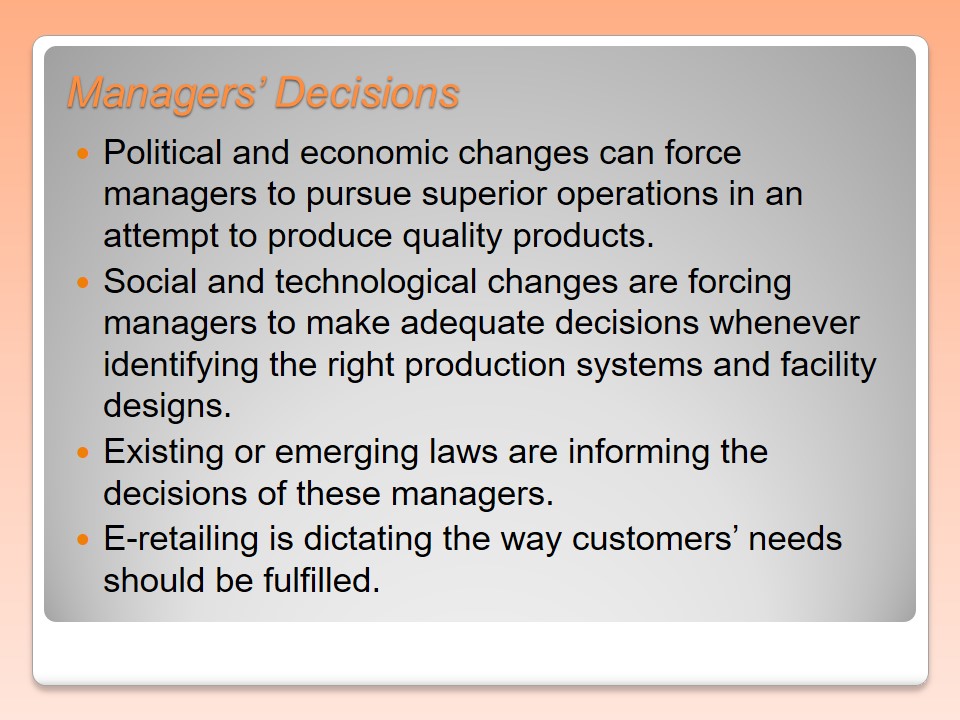
Improving Operational Efficiencies
- Planning and organizing: Managers should be ready to plan, solve emerging problems, and communicate vision to different stakeholders.
- Directing and staffing: Since new trends are emerging every day, leaders must develop motivated teams that can focus on emerging fashions and come up with the best ideas to deliver them to more potential customers (Choi & Li 2015).
- Controlling: Metrics such as quality of apparels, effectiveness of marketing processes, and nature of the existing lean model are used to control operations.
Several measures can be taken into consideration to improve operational efficiencies and make it easier for more corporations in this industry to achieve their objectives. Organizing and planning processes will empower them to monitor the existing business strategy or model and improve it accordingly. Continuous collaboration between followers and managers will ensure that emerging conflicts are addressed. Resources such as finances, persons, and raw materials must also be identified and acquired. Managers must also supervise and empower their subordinates. Teams should be designed and motivated using appropriate leadership models (Choi & Li 2015). For instance, managers should become good listeners, communicators, problem-solvers, and decision-makers. They should coordinate and direct different functions to ensure that each of the intended operation is pursued diligently. Controlling is relevant since it empowers leaders to maintain desirable performance goals or standards. Competent managers must review existing operations management processes and present appropriate insights to implement desirable improvements.

Conclusion and Recommendations
- Operations management processes can deliver positive results.
- Superior approaches such as lean and JIT can add value to business processes and maximize performance.
- The targeted organization must, therefore, focus on emerging industry trends and use operations management processes efficiently.
- Managers in this organization must engage their employees to improve operations management functions.
This presentation has revealed that fast fashion businesses have numerous opportunities and threats. External factors such as new laws, social and economic changes, and technological advancements should be monitored continuously to inform production, marketing, and planning processes. Social media networks can also be used to collect adequate data and market every product to the greatest number of customers. Concepts such as lean and JIT should be considered to streamline various operations management processes.
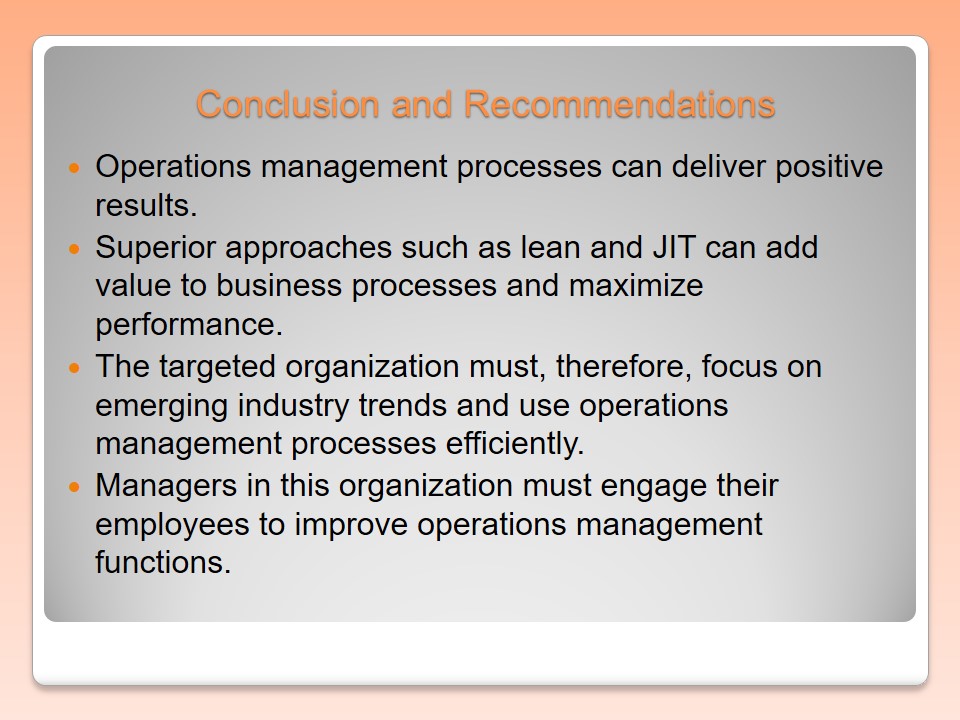
Reference List
Choi, T & Li, Y 2015, ‘Sustainability in fashion business operations’, Sustainability, vol. 7, no. 1, pp. 15400-15406.
Ciarniene, R & Vienazindiene, M 2014, ‘Agility and responsiveness managing fashion supply chain’, Procedia – Social and Behavioral Sciences, vol. 150, no. 1, pp. 1012-1019.
Hill, A & Hill, T 2018, Essential operations management 2nd ed, Palgrave, London.
Hu, Z & Yu, X 2014, ‘Optimization of fast-fashion apparel transshipment among retailers’, Textile Research Journal, vol. 84, no. 20, pp. 2127-2139.
Libanio, CS & Amaral, FG 2017, ‘A design management framework for the fashion industry’, Brazilian Business Review, vol. 14, no. 1, pp. 1-20.
Lion, A, Macchion, L, Danese, P & Vinelli, A 2016, ‘Sustainability approaches within the fashion industry: the supplier perspective’, Supply Chain Forum: An International Journal, vol. 17, no. 2, pp. 95-108.